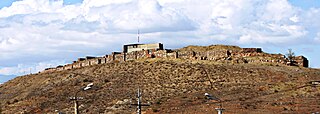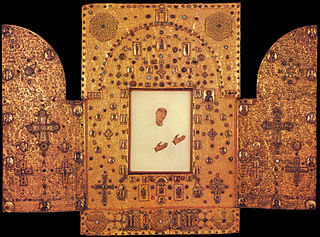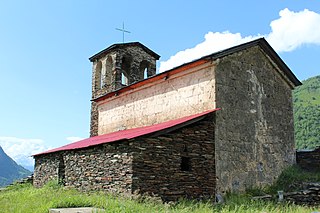
The Romaniote Jews or the Romaniotes are a Greek-speaking ethnic Jewish community native to the Eastern Mediterranean. They are one of the oldest Jewish communities in existence and the oldest Jewish community in Europe. The Romaniotes have been, and remain, historically distinct from the Sephardim, some of whom settled in Ottoman Greece after the expulsion of Jews from Spain and Portugal after 1492.

Ioannina, often called Yannena within Greece, is the capital and largest city of the Ioannina regional unit and of Epirus, an administrative region in north-western Greece. According to the 2011 census, the city population was 65,574, while the municipality had 112,486 inhabitants. Ten years later, the population of the city had seen a minor increase to 113,978 inhabitants. It lies at an elevation of approximately 500 metres above sea level, on the western shore of Lake Pamvotis (Παμβώτις). Ioannina is located 410 km (255 mi) northwest of Athens, 260 kilometres southwest of Thessaloniki and 80 km east of the port of Igoumenitsa on the Ionian Sea.

The Bachkovo Monastery of the Dormition of the Theotokos, archaically the Petritsoni Monastery or Monastery of the Mother of God Petritzonitissa is a major Eastern Orthodox monastery in Southern Bulgaria. It is located on the right bank of the Chepelare River, 189 km from Sofia and 10 km south of Asenovgrad, and is directly subordinate to the Holy Synod of the Bulgarian Orthodox Church. The monastery is known and appreciated for the unique combination of Byzantine, Georgian and Bulgarian culture, united by the common faith.

Erebuni Fortress is an Urartian fortified city, located in Yerevan, Armenia. It is 1,017 metres (3,337 ft) above sea level. It was one of several fortresses built along the northern Urartian border and was one of the most important political, economic and cultural centers of the vast kingdom. The name Yerevan itself is derived from Erebuni.

The Mond Crucifixion or Gavari Altarpiece is an oil on poplar panel dated to 1502–1503, making it one of the earliest works by Italian Renaissance artist Raphael, perhaps the second after the c.1499-1500 Baronci Altarpiece. It originally comprised four elements, of which three survive, now all separated: a main panel of the Crucified Christ with the Virgin Mary, Saints and Angels which was bequeathed to the National Gallery, London, by Ludwig Mond, and a three-panel predella from which one panel is lost; the two surviving panels are Eusebius of Cremona raising Three Men from the Dead with Saint Jerome's Cloak in the Museu Nacional de Arte Antiga, in Lisbon, and Saint Jerome saving Silvanus and punishing the Heretic Sabinianus in the North Carolina Museum of Art.

A Hodegetria, or Virgin Hodegetria, is an iconographic depiction of the Theotokos holding the Child Jesus at her side while pointing to him as the source of salvation for humankind. The Virgin's head usually inclines towards the child, who raises his hand in a blessing gesture. In the Western Church this type of icon is sometimes called Our Lady of the Way.

The Paul and Alexandra Canellopoulos Museum is a museum of antiquities in Athens, Greece. It is situated in the north slope of Acropolis, in the district of Plaka. Founded in 1976, it houses the collection of Paul and Alexandra Canellopoulos, which started being formed in 1923 and was donated to the Greek state in 1972. The collection features ca. 6500 items of Prehistoric, Ancient Greek, Byzantine and post-Byzantine art, spanning almost six millennia of history.

The Archaeological Museum of Ioannina is a museum located in Litharitsa Park in the centre of Ioannina, Greece.

The Museum of Byzantine Culture is a museum in Thessaloniki, Central Macedonia, Greece, which opened in 1994.

The Khakhuli triptych is a partially preserved large repoussé triptych icon of the Theotokos created in medieval Georgia. It incorporates over 100 specimens of Georgian and Byzantine cloisonné enamel dated from the 8th to the 12th century. The icon is now on display at Art Museum of Georgia in Tbilisi.

The Ancha Icon of the Savior, known in Georgia as Anchiskhati, is a medieval Georgian encaustic icon, traditionally considered to be the Keramidion, a "holy tile" imprinted with the face of Jesus Christ miraculously transferred by contact with the Image of Edessa (Mandylion). Dated to the 6th-7th century, it was covered with a chased silver riza and partly repainted in the following centuries. The icon derives its name from the Georgian monastery of Ancha in what is now Turkey, whence it was brought to Tbilisi in 1664. The icon is now kept at the National Art Museum of Georgia in Tbilisi.

The Church of St. George is a 12th-century Macedonian Orthodox church located 2 km away from the village of Kurbinovo in North Macedonia. Excavations have shown that the building has once belonged to a settlement, which was abandoned at the end of the 18th century for the present-day village of Kurbinovo. According to the research made on the church's frescoes, it is supposed that the church was built in the year 1191 by the Byzantines. The church is a "monument of culture" in the Republic of North Macedonia and protected by law. It is also a part of the Prespa - Pelagonia diocese of the Macedonian Orthodox Church.

The Ioannina Castle is the fortified old town of the city of Ioannina in northwestern Greece. The present fortification dates largely to the reconstruction under Ali Pasha in the late Ottoman period, but incorporates also pre-existing Byzantine elements.

Saint Neophytos Monastery lies in the territory of the community of Tala, 1 km north of the village, and 15 km west of Paphos, is one of the best-known monasteries in Cyprus. It was founded by monk Neophytos in the 12th century. The property is currently a museum consisting of the Engleistra and the Monastery. Agios Neofytos lies 4 km west of Tremithousa, and across the steep valley from the Tsiárta mountain.

Christ Bearing the Cross is a painting in tempera attributed to the Greek painter Nikolaos Tzafouris. Tzafouris is considered one of the founding members of the Cretan School along with Andreas Ritzos, Andreas Pavias, and Angelos Akotantos. He was influenced by Angelos Akotantos. According to the Institute of Neohellenic Research, thirteen paintings are attributed to Tzafouris. Active between 1480 and 1501, Tzafouris had a workshop in Heraklion, where he painted religious themes for local churches. His most notable works are the Madre della Consolazione and Christ Bearing the Cross.

The Ihlara Valley is a canyon which is 15 km long and up to 150 m deep in the southwest of the Turkish region of Cappadocia, in the municipality of Güzelyurt, Aksaray Province. The valley contains around 50 rock-hewn churches and numerous rock-cut buildings.

The Kala church of Saints Cyricus and Julitta, locally known as Lagurka (ლაგურკა), is a medieval church in the Mestia Municipality in Georgia's region of Samegrelo-Zemo Svaneti. The area is part of the highland historical and cultural region of Upper Svaneti where Lagurka is regarded as the principal Christian shrine, its designation deriving from the name of Cyricus in the local Svan language. It is a hall church, adorned with frescoes painted by Tevdore in 1111/1112, one of the high points of medieval Georgian monumental art. The church is inscribed on the list of the Immovable Cultural Monuments of National Significance of Georgia.

The Monastery of Panagia Molyvdoskepastos is a male Greek Orthodox monastery at Molyvdoskepastos, near Konitsa, Epirus, in North Western Greece.

Georgios Nomikos was a Greek painter. He converted to Christianity from Judaism. He was a Greek Baroque painter. He was a member of the Cretan School and the Heptanese School. His contemporaries were Georgios Kastrofylakas, Theodore Poulakis, and Georgios Markou. He shared the same last name with famous Greek painter Demetrios Nomikos. He was active on the island of Zakynthos, Kefalonia Arta and Ioannina. Six of his paintings survived. Some of his frescos have survived in the destroyed church of Saint George in Lingiades, Ioannina. His work represents an evolution from the art of Angelos Akotantos and Elias Moskos to a more refined technique influenced by the art of the Ionion Islands.



















